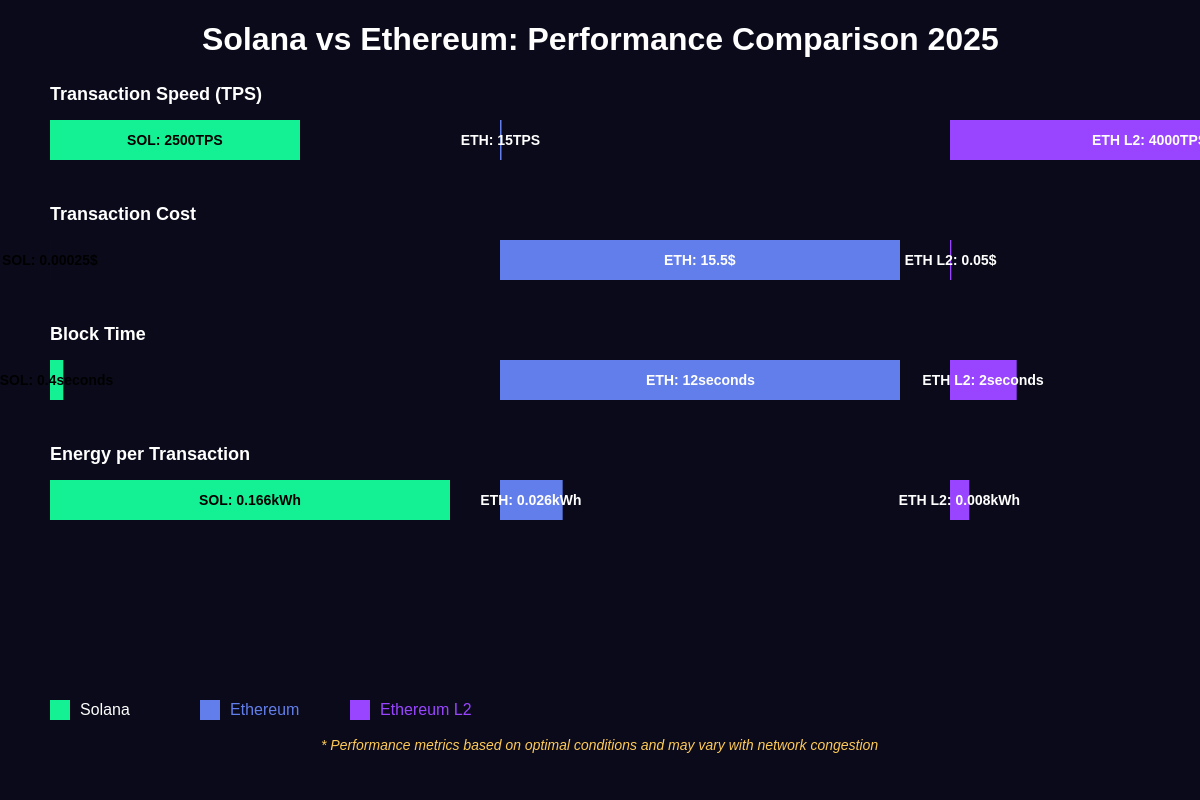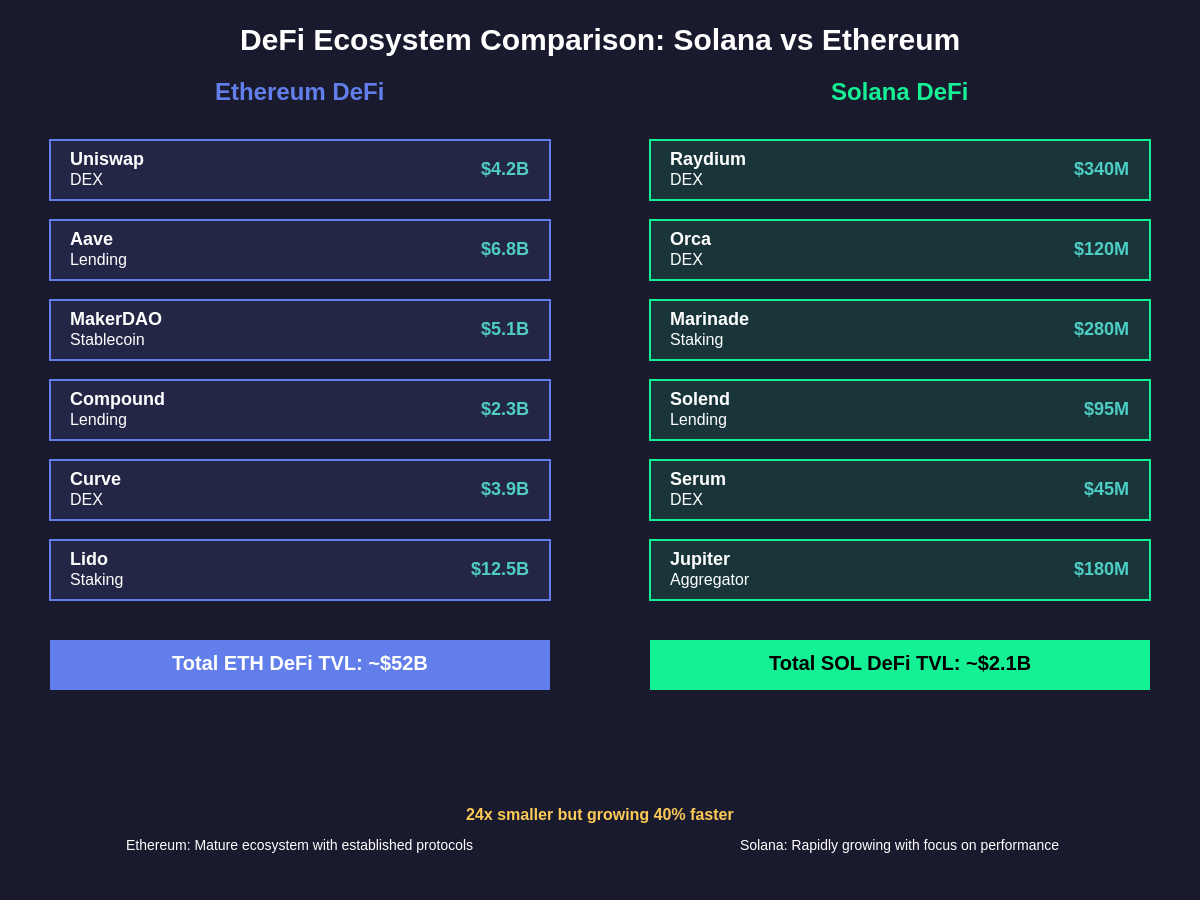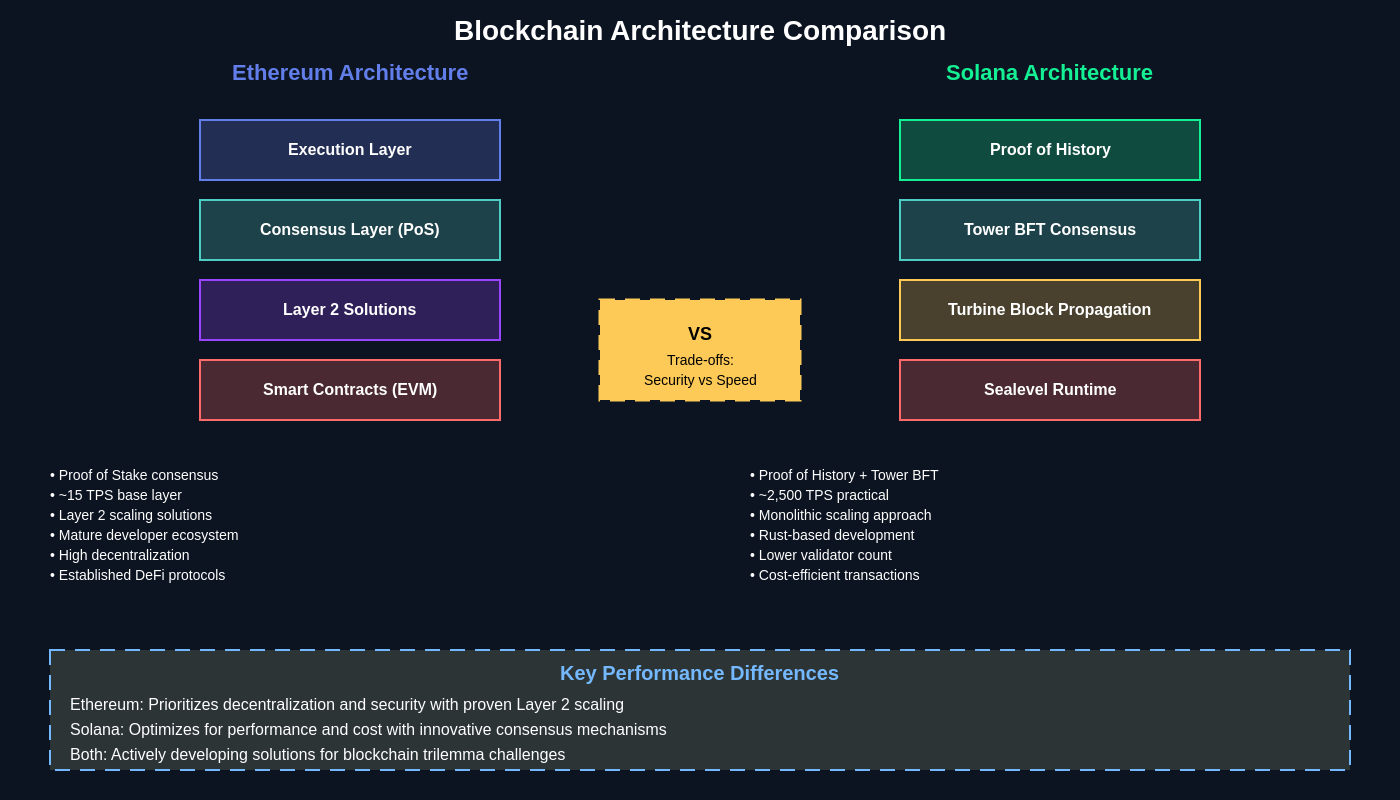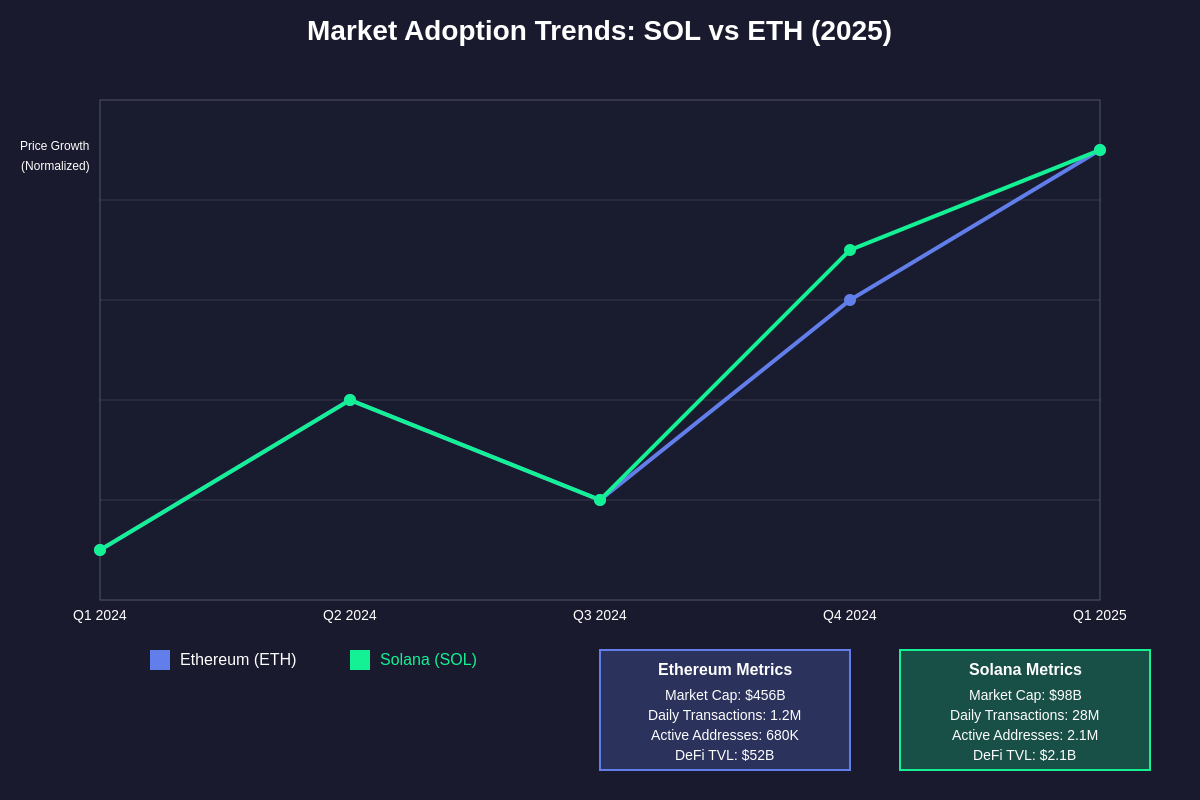The Great Blockchain Rivalry Intensifies
The cryptocurrency landscape has witnessed one of the most compelling technological battles in its history as Solana and Ethereum continue their fierce competition for decentralized finance supremacy throughout 2025. This rivalry extends far beyond simple market capitalization comparisons, encompassing fundamental differences in architecture, philosophy, and approach to solving blockchain scalability challenges that have defined the evolution of decentralized applications and financial services.
Ethereum’s established dominance in the DeFi sector faces unprecedented challenges from Solana’s high-performance blockchain architecture, which promises to deliver the speed and cost efficiency that many believe are essential for mainstream cryptocurrency adoption. The stakes in this competition could not be higher, as the winner will likely shape the future of decentralized finance, non-fungible tokens, and Web3 applications for the next decade.
Technical Architecture and Performance Metrics
The fundamental differences between Solana and Ethereum begin at the architectural level, where each blockchain has adopted radically different approaches to achieving scalability, security, and decentralization. Ethereum’s transition to Proof of Stake through Ethereum 2.0 represents a methodical evolution of its existing infrastructure, while Solana was designed from the ground up with performance as its primary consideration.

Ethereum’s current throughput of approximately 15 transactions per second on the base layer remains a significant limitation despite the implementation of various Layer 2 scaling solutions including Optimism, Arbitrum, and Polygon. These Layer 2 networks have successfully increased transaction capacity and reduced costs, but they introduce additional complexity and potential security trade-offs that developers and users must navigate when building and using DeFi applications.
Solana’s architecture achieves dramatically higher throughput through its innovative Proof of History consensus mechanism combined with Tower BFT, enabling theoretical transaction speeds of up to 65,000 transactions per second under optimal conditions. Real-world performance typically ranges between 2,000 to 5,000 transactions per second, which still represents a substantial improvement over Ethereum’s base layer capabilities while maintaining significantly lower transaction costs.
The price performance of SOL versus ETH reflects these technical capabilities, with Solana often outperforming during periods when network activity and transaction volume spike due to its superior handling of high-demand scenarios.
DeFi Ecosystem Development and Total Value Locked
The decentralized finance ecosystem represents the primary battleground where Solana and Ethereum compete for developer mindshare and user adoption, with total value locked serving as a key metric for measuring the success and maturity of each platform’s DeFi infrastructure. Ethereum maintains a substantial lead in total value locked across its DeFi protocols, with over $50 billion secured in various lending, borrowing, trading, and yield farming applications.

Ethereum’s DeFi ecosystem benefits from first-mover advantage and the extensive development of protocols including Uniswap, Aave, Compound, MakerDAO, and Curve Finance, which have established themselves as foundational infrastructure for decentralized finance. The composability of these protocols, often referred to as “money legos,” enables developers to build sophisticated financial products by combining existing DeFi primitives in innovative ways.
Solana’s DeFi ecosystem has experienced rapid growth with protocols such as Serum, Raydium, Orca, and Marinade Finance attracting significant liquidity and trading volume. The lower transaction costs and faster confirmation times on Solana enable new types of DeFi applications that would be economically unfeasible on Ethereum, including high-frequency trading strategies and micro-transaction-based services.
Developer Experience and Ecosystem Maturity
The developer experience represents a crucial factor in determining long-term success for blockchain platforms, as the quality of development tools, documentation, and community support directly impacts the rate of innovation and application deployment. Ethereum’s mature development ecosystem includes comprehensive tooling such as Truffle, Hardhat, and Remix, along with extensive documentation and a large community of experienced Solidity developers.
Ethereum’s programming language Solidity has become the de facto standard for smart contract development, with thousands of developers worldwide possessing expertise in writing, auditing, and deploying Ethereum-based applications. The extensive library of open-source smart contracts and battle-tested security patterns provides developers with reliable foundations for building complex DeFi applications.
Solana’s development experience centers around the Rust programming language, which offers superior performance characteristics and memory safety compared to Solidity but requires developers to learn a more complex programming paradigm. The Solana development toolkit includes Anchor framework, which simplifies smart contract development, and various debugging and testing tools designed specifically for the Solana runtime environment.
The learning curve for Solana development is generally steeper than Ethereum development, which has implications for developer adoption and the speed at which new projects can launch on the platform. However, developers who master Solana’s development environment often report significant advantages in terms of application performance and user experience capabilities.
Network Reliability and Uptime Considerations
Network reliability has emerged as a critical differentiator between Solana and Ethereum, with each platform facing unique challenges related to maintaining consistent uptime and transaction processing capabilities under varying load conditions. Ethereum’s network has demonstrated remarkable stability over its seven-year operational history, with few significant outages or performance degradations that have impacted user access to DeFi applications.
Solana has experienced several notable network outages and performance issues since its mainnet launch, including extended periods of reduced transaction processing capacity and complete network halts that required validator coordination to resolve. These reliability concerns have raised questions about Solana’s readiness for mission-critical financial applications, particularly among institutional users who require guaranteed uptime for their operations.
The causes of Solana’s network issues often relate to the high-performance nature of its architecture, which can become overwhelmed during periods of extreme network activity such as major NFT drops or DeFi protocol launches. While the Solana development team has implemented various improvements to address these reliability concerns, the trade-off between performance and stability remains an ongoing challenge.
Ethereum’s transition to Proof of Stake has improved its energy efficiency without compromising the network reliability that users and developers have come to expect. The extensive testing and gradual rollout of Ethereum 2.0 upgrades demonstrates a conservative approach to network changes that prioritizes stability over rapid performance improvements.
Transaction Costs and Economic Models
The economic models underlying Solana and Ethereum create fundamentally different user experiences and determine the types of applications that can operate economically on each platform. Ethereum’s fee structure, based on gas prices that fluctuate with network demand, can result in transaction costs ranging from a few dollars during low-demand periods to hundreds of dollars during network congestion events.
These high transaction costs on Ethereum have driven innovation in Layer 2 scaling solutions, which offer reduced fees while maintaining security guarantees through various mechanisms including optimistic rollups and zero-knowledge proofs. Users must navigate the complexity of bridging assets between Ethereum mainnet and Layer 2 networks, which introduces additional steps and potential security considerations.
Solana’s fee structure maintains consistently low transaction costs, typically ranging from $0.00025 to $0.01 per transaction regardless of network demand. This predictable and affordable fee structure enables applications that require frequent user interactions, such as gaming applications, social media platforms, and high-frequency trading systems that would be prohibitively expensive on Ethereum.
The economic sustainability of these different fee models remains an open question, as Solana’s low fees may not provide sufficient incentives for validators during periods of reduced block rewards, while Ethereum’s high fees can price out smaller users and limit mainstream adoption potential.
Institutional Adoption and Enterprise Integration
Institutional adoption patterns reveal important differences in how enterprises and traditional financial institutions approach Solana versus Ethereum for their blockchain initiatives and cryptocurrency integration strategies. Ethereum’s longer operational history and larger developer ecosystem have made it the preferred choice for many institutional DeFi applications and enterprise blockchain projects.
Major financial institutions including JPMorgan Chase, Goldman Sachs, and Morgan Stanley have conducted blockchain experiments and pilot programs primarily on Ethereum-based infrastructure, leveraging the platform’s established protocols and extensive auditing history. The regulatory clarity around Ethereum, particularly following the transition to Proof of Stake, has improved its attractiveness for compliance-conscious institutions.
Solana has attracted institutional interest from organizations focused on high-performance applications and cost-sensitive use cases, including payment processors, trading firms, and consumer-facing applications that require fast transaction settlement. The Solana Foundation’s enterprise partnership program has facilitated adoption among companies seeking alternatives to traditional payment rails and database systems.
The comparative performance metrics between SOL and ETH often reflect institutional adoption trends, with sustained price movements frequently corresponding to major partnership announcements or enterprise integration milestones.
NFT Markets and Digital Asset Innovation
The non-fungible token market has become another arena where Solana and Ethereum compete for creator and collector mindshare, with each platform offering distinct advantages for different types of digital asset projects and trading strategies. Ethereum established the foundational standards for NFTs through ERC-721 and ERC-1155 token standards, which have been adopted across the industry and form the basis for most major NFT marketplaces and collections.
Ethereum’s NFT ecosystem includes established marketplaces such as OpenSea, Foundation, and SuperRare, which collectively process billions of dollars in trading volume and host some of the most valuable digital art collections and profile picture projects. The cultural significance and brand recognition of Ethereum-based NFT projects like CryptoPunks and Bored Ape Yacht Club have established Ethereum as the premium platform for high-value digital collectibles.
Solana’s NFT ecosystem has grown rapidly around marketplaces including Magic Eden, Solanart, and DigitalEyes, which leverage the platform’s low transaction costs to enable new types of NFT experiences including frequent trading, gaming integrations, and utility-focused projects. The reduced friction for minting and trading NFTs on Solana has attracted creators who prioritize accessibility and community engagement over maximum sale prices.
The technical capabilities of each platform influence the types of NFT projects that can be successfully implemented, with Solana’s performance advantages enabling dynamic NFTs, on-chain gaming assets, and interactive digital experiences that would be cost-prohibitive on Ethereum’s base layer.
Decentralization and Governance Considerations
The degree of decentralization achieved by Solana and Ethereum represents a fundamental philosophical difference that impacts their long-term security, censorship resistance, and community governance capabilities. Ethereum’s extensive validator set, distributed across thousands of operators worldwide, provides strong decentralization guarantees that have been tested through various network upgrade controversies and regulatory challenges.
Ethereum’s governance model relies on rough consensus among stakeholders including developers, validators, and the broader community, with major upgrades requiring extensive discussion and coordination across multiple implementation teams. This conservative approach to governance changes prioritizes network stability and backward compatibility while potentially slowing the pace of innovation and optimization.
Solana’s validator set, while growing, remains more concentrated than Ethereum’s, with higher hardware requirements and technical complexity potentially limiting the diversity of validator operators. The Solana Foundation’s influence over network development and validator incentives raises concerns about centralization, though the foundation has committed to reducing its control over time.
The governance mechanisms for protocol upgrades and parameter changes differ significantly between the platforms, with Solana enabling more rapid implementation of improvements while Ethereum’s more distributed governance structure provides stronger protection against arbitrary changes that could harm network participants.
Layer 2 Solutions and Scaling Roadmaps
The scaling strategies pursued by Solana and Ethereum reflect different philosophies about how blockchain networks should evolve to meet growing demand for decentralized applications and financial services. Ethereum’s Layer 2-centric approach acknowledges the limitations of its base layer while creating a vibrant ecosystem of scaling solutions that cater to different use cases and security requirements.

Ethereum’s Layer 2 ecosystem includes optimistic rollups such as Optimism and Arbitrum, which provide near-native compatibility with existing Ethereum applications while offering significantly reduced transaction costs and faster confirmation times. Zero-knowledge rollups including Polygon zkEVM and zkSync provide different trade-offs between performance and security, with ongoing development focused on improving developer experience and interoperability.
The complexity of Ethereum’s Layer 2 landscape creates both opportunities and challenges for users and developers, who must navigate different bridging mechanisms, security assumptions, and liquidity fragmentation across multiple networks. However, this diversity also provides options for applications with specific requirements around cost, speed, and security.
Solana’s scaling approach focuses on optimizing the base layer performance through hardware improvements, software optimizations, and network infrastructure upgrades rather than creating separate scaling layers. This monolithic scaling strategy avoids the complexity of Layer 2 systems while potentially limiting the platform’s ability to customize performance characteristics for different use cases.
Gaming and Web3 Application Development
The gaming sector represents a significant growth opportunity for blockchain platforms, with Solana and Ethereum competing to provide the infrastructure necessary for next-generation gaming experiences that integrate digital ownership, play-to-earn mechanics, and decentralized virtual economies. The performance requirements of gaming applications often exceed what traditional blockchain networks can provide, making this sector a crucial test of each platform’s technical capabilities.
Ethereum-based gaming projects have focused primarily on turn-based games, collectible card games, and virtual world applications that can operate effectively despite higher transaction costs and slower confirmation times. Projects like Axie Infinity, The Sandbox, and Decentraland have demonstrated the potential for blockchain gaming while highlighting the limitations imposed by Ethereum’s performance characteristics.
Solana’s gaming ecosystem has attracted developers building more performance-intensive applications including real-time strategy games, first-person shooters, and massively multiplayer online games that require frequent transaction processing and minimal latency. The lower costs and faster transactions on Solana enable gaming mechanics that would be economically unfeasible on Ethereum, such as micro-transactions for in-game items and frequent state updates.
The development tools and frameworks available for gaming on each platform continue to evolve, with specialized SDKs and libraries designed to simplify the integration of blockchain functionality into traditional game engines and development workflows.
Cross-Chain Interoperability and Bridge Solutions
The ability to move assets and data between Solana and Ethereum has become increasingly important as users and applications seek to leverage the unique advantages of each platform while maintaining access to liquidity and services across the broader cryptocurrency ecosystem. Various bridge solutions have emerged to facilitate cross-chain interactions, each with different security models and user experience considerations.
Popular bridge solutions including Wormhole, Allbridge, and Portal enable users to transfer tokens between Solana and Ethereum, though these bridges introduce additional security risks and require users to understand the trade-offs associated with wrapped tokens and cross-chain asset representations. The security of bridge solutions has been tested through various exploit attempts and successful attacks that have resulted in significant fund losses.
The technical challenges of maintaining secure cross-chain bridges reflect the fundamental differences between Solana and Ethereum’s consensus mechanisms, state models, and cryptographic primitives. Developers building cross-chain applications must carefully consider these differences when designing systems that operate across multiple blockchain networks.
Future developments in cross-chain interoperability may reduce the importance of choosing between Solana and Ethereum for specific applications, as improved bridge solutions and interoperability protocols could enable seamless interaction between different blockchain ecosystems.
Regulatory Environment and Compliance Considerations
The regulatory landscape surrounding blockchain platforms continues to evolve, with Solana and Ethereum facing different challenges and opportunities based on their technical characteristics, governance structures, and ecosystem development patterns. Ethereum’s transition to Proof of Stake has addressed some regulatory concerns about energy consumption while potentially creating new considerations around staking centralization and validator responsibilities.
The classification of SOL and ETH tokens under various regulatory frameworks impacts their accessibility to institutional investors and their integration into traditional financial products and services. Ethereum’s longer regulatory history and clearer precedents provide some advantages for compliance-focused organizations, while Solana’s newer status creates both opportunities and uncertainties.
Regulatory developments in major jurisdictions including the United States, European Union, and Asia-Pacific region will likely influence the competitive dynamics between Solana and Ethereum, particularly in areas such as DeFi regulation, stablecoin requirements, and institutional custody standards.
Future Roadmap and Development Priorities
The development roadmaps for Solana and Ethereum reveal different priorities and approaches to addressing current limitations while positioning for future growth in the decentralized application and financial services sectors. Ethereum’s roadmap focuses on completing the transition to Proof of Stake, implementing sharding for improved scalability, and enhancing the developer experience through various Ethereum Improvement Proposals.
Ethereum’s long-term vision includes the implementation of stateless clients, improved virtual machine efficiency, and enhanced privacy features that will maintain its position as a leading smart contract platform. The methodical approach to these upgrades prioritizes backward compatibility and network stability while gradually improving performance and reducing resource requirements.
Solana’s development priorities center around improving network reliability, expanding validator decentralization, and optimizing performance for high-demand scenarios. The Solana roadmap includes enhancements to the consensus mechanism, improvements to developer tooling, and expansion of the validator ecosystem to improve geographic and operational diversity.
Both platforms continue to invest heavily in research and development, with significant resources dedicated to solving fundamental blockchain challenges including scalability, security, and user experience. The outcomes of these development efforts will likely determine the long-term competitive positioning of each platform in the evolving cryptocurrency landscape.
Market Performance and Investment Considerations
The investment characteristics of SOL and ETH tokens reflect both the technical capabilities of their underlying platforms and the broader market dynamics affecting cryptocurrency adoption and speculation. Historical price movements of Solana have often been more volatile than Ethereum due to its newer status and smaller market capitalization, while Ethereum’s larger size and institutional adoption have provided relatively more stability.

The correlation between token prices and platform adoption metrics including transaction volume, developer activity, and total value locked provides insights into how the market values the different approaches taken by Solana and Ethereum. Periods of high network activity on either platform often correspond to increased token demand and price appreciation, though this relationship can be complicated by broader cryptocurrency market trends.
Investment considerations for SOL versus ETH include factors such as regulatory risk, technical risk, competitive positioning, and the potential for mainstream adoption of each platform’s applications and services. The different risk profiles and growth potential of each platform may appeal to different types of investors with varying risk tolerance and investment time horizons.
TradingView’s comprehensive analysis tools provide detailed insights into the technical analysis patterns and market sentiment surrounding both SOL and ETH, enabling investors to make more informed decisions about their cryptocurrency allocations.
Conclusion: The Ongoing Battle for Blockchain Supremacy
The competition between Solana and Ethereum for DeFi dominance in 2025 represents more than a simple technological rivalry, embodying fundamental questions about the future of decentralized systems, the trade-offs between performance and decentralization, and the optimal approaches to scaling blockchain technology for mainstream adoption. Both platforms have demonstrated unique strengths and faced significant challenges that will continue to shape their development and adoption trajectories.
Ethereum’s established ecosystem, institutional adoption, and conservative approach to upgrades provide stability and reliability that many developers and users value, while Solana’s performance advantages and cost efficiency enable new types of applications and user experiences that may prove essential for cryptocurrency’s mainstream adoption. The ultimate winner of this competition may not be determined by technical superiority alone, but by the ability to balance multiple competing priorities including security, scalability, decentralization, and user experience.
The evolution of this rivalry will likely continue to drive innovation across the entire cryptocurrency ecosystem, with both platforms pushing the boundaries of what is possible with blockchain technology while competing for developer mindshare, user adoption, and institutional investment. The beneficiaries of this competition include the broader cryptocurrency community, which gains access to improved tools, applications, and financial services regardless of which platform ultimately achieves dominance.
As the DeFi landscape continues to mature and evolve throughout 2025 and beyond, the success of Solana and Ethereum will be measured not only by their individual achievements but by their contributions to the broader goal of creating a more open, accessible, and efficient financial system that serves users worldwide. The battle for DeFi dominance remains far from over, with both platforms positioned to play crucial roles in the ongoing transformation of global finance and the development of Web3 applications.
TradingView Pine Script Reference
Disclaimer: This article is for informational purposes only and does not constitute financial advice. Cryptocurrency investments carry significant risks, including the potential for complete loss of capital. The content presented here is based on publicly available information and analysis, but market conditions can change rapidly. Readers should conduct their own research and consult with qualified financial advisors before making any investment decisions. The author and publisher are not responsible for any financial losses that may result from the use of this information. Past performance does not guarantee future results, and all investments in cryptocurrencies should be considered speculative and high-risk.